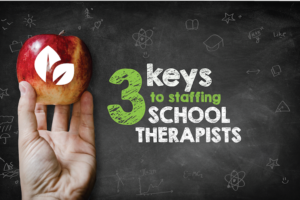Efficient onboarding is vital to the productivity of your temporary travel employees. With proper training right from the start, your travel therapists will be able to join your workforce as seamlessly as possible. You’ll help prevent the hiccups that can be associated with a lack of training for new staff members, including confusion, frustration, and lost productivity on the job. Here’s what you can do.
Tips for onboarding your travel staff
Since your travel therapists’ assignments are temporary—usually just 13 weeks—you can maximize your staffing investment when you begin onboarding even before their start date. Follow these tips to help your travel therapists to be successful while on assignment at your facility:
- Communicate regularly with your staffing consultant. Your consultant is a valuable resource to you. He or she will make sure your travel employee is ready to go in terms of payroll, applicable credentials, etc. Your consultant needs your timely response in order to relay information to your new travel therapist. A quick response from you keeps the ball rolling.
- Inform your full-time staff. Take action to maintain positive energy and a harmonious environment between your travel therapist and his or her coworkers. In advance of the travel worker’s arrival, inform the team he or she will be working with. Explain that the temporary worker will be helping to cover the patient load for a while, but is not meant to replace any of your full-timers
- Provide facility information in advance. Before your therapist’s first day, supply your staffing consultant with a packet of all necessary facility information. This should include directions to the facility, parking information, how to obtain an ID badge and computer log in credentials, dress code, and corporate policies and procedures. Some facilities assume a therapist will figure out these basic items, however, providing them before the start date speeds up the onboarding process and prevents miscommunication.
- Provide a comprehensive orientation. Ideally and in the interest of time, orientation should happen on the travel therapist’s first day. Outlining the travel therapist’s new role and responsibilities clarifies your expectations from the start. A great orientation includes the following:
- A tour of the facility
- Directions for whom to ask on-the-job questions, based on the nature of the topic.
- Directions for scheduling concerns, especially if the therapist is slow or has too large a patient load.
- What to do about overtime—should the therapist try to avoid it, and what should he or she do if it’s necessary due to a large patient load?
- Timesheet Instructions—who signs them and where to send them.
- How to use the computer system for charting—supply username and password, and any information the therapist will need to know to use the system.
- Assign a job “buddy.” Your new travel worker will probably have questions during the first few days of this new assignment. By assigning a co-worker to serve as a mentor, you’ll help ensure your new staff member learns his or her position quickly, but also correctly.
- Extend a warm welcome. It can be difficult when you’re the new person! Welcome your travel therapist by including him or her in an after-work outing during his or her first week, or taking the time to show him or her around town. This could include a dinner, happy hour or any other activity.
Help your travel therapist help you
You’ve hired a travel worker to help supplement your staff and keep business moving as usual. He or she is prepared to do the best job possible, and will benefit from the above support to complete the assignment with flying colors.
If you’re looking for travel therapy staff, contact myPTsolutions
We work with employers across the country for placement of travel therapists and other allied healthcare professionals. To learn more about how myPTsolutions can help you reach your staffing goals, contact us today.



